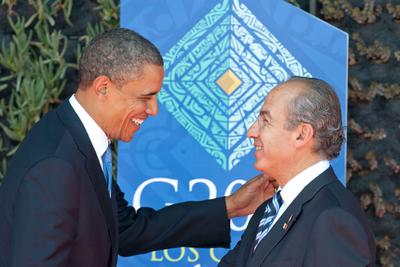Many trade analysts predict that the move by Canada and Mexico will produce a domino effect, beginning with the addition of Japan and South Korea within the next year. That would produce a free trade area encompassing more than 700 million people with a combined GDP of some US$26 trillion. This prospect gives substance to the claim that, in an otherwise lackluster and frustrating G20 summit, the announcement about Mexico and Canada joining the TPP negotations is a really big deal.
For most of their history, the TPP negotiations have been conducted beneath the radar of publicity and media attention. They began in 2005 with four small nations — Singapore, Brunei, New Zealand and Chile (P4) — aiming for a high-standard, US-model Free Trade Agreement, with the goal of providing a pathway to an inclusive, trans-Pacific trade and investment open market. Australia, Peru, Vietnam and Malaysia subsequently signed on, but the transforming event came during the last months of the Bush administration, with the announcement that the US would be joining the TPP.
Though conflicted and hampered by a Democratic Party deeply divided on trade policy, the incoming Obama administration decided after months of deliberations that its much-touted ‘pivot’ to Asia would have little credibility without US leadership toward greater trade and investment liberalisation throughout the region. The decision was also prompted by the fact that Beijing was busily promoting an intra-Asian trade structure that would exclude the US.
Detailed negotiations for the TPP began in early 2010, and since then 13 rounds have been conducted. Aware that the WTO Doha Round has bogged down in failure after a decade-long slog, the TPP nations set an ambitious goal of completing the pact by the end of 2012. They will not meet that goal, but most observers believe that they will work through the remaining issues — including new rules on intellectual property, market access, rules of origin and investor–state dispute settlement — by the middle of 2013.
One complicating factor is the uniqueness of the negotiating process: unlike any previous trade negotiation, TPP negotiators face the challenge of adding new members (Mexico and Canada, and possibly others) as they are hammering out the details of the pact itself. To avoid reinventing the wheel in the coming months, Canada and Mexico have agreed not to reopen sections of the text where issues have been settled.
What differentiates the TPP from other trade agreements is that it aims to lower or eliminate behind the border barriers to competition from foreign goods and services. Thus, the agreement sets out rules for government procurement, services (including financial, telecommunications, accounting), investment, health and safety regulations, intellectual property, fair competition with state-owned-enterprises, supply chain management, and regulatory due process. If the negotiations succeed, these features will turn the TPP into a model 21st-century FTA.
Despite the emphasis on 21st-century regulatory reform, it turns out that some longstanding 20th-century trade issues are proving the most difficult to resolve. For the US, the greatest challenges stem from sugar, dairy and cotton protection and subsidies; textiles and so-called rules of origin that hamper clothing supply chains; and union demands for interference with the labor laws of US trading partners.
In the end, the key to success will come down to trade-offs between 21st century liberalisation and old-fashioned 20th-century protectionism. By all economic analyses, the benefits are clearly worth the short-term adjustment costs. The most widely cited study estimates that region-wide integration in the Asia Pacific would generate almost US$2 trillion in additional trade by 2025, with an additional US$290 million for US exports.
Much could go wrong in the crucial endgame negotiations after the US elections and in the first months of 2013. For instance, the Obama administration has fed the high ambitions of American corporations to get their way on major issues. But there are bound to be disappointments and compromises for which they have been little prepared.
Conversely, other TPP members may reciprocate with rigid final positions — New Zealand on intellectual property, or Australia on the international arbitration of investor disputes are likely candidates. Yet over the past two years, a strong esprit and commitment has developed, and there is a reasonable chance that the negotiators can craft workarounds for the most intractable differences.
In the weeks before the G20 summit, the Obama administration seemed to be dragging its feet on the way to delivering the crucial invitations to Canada and Mexico. But they have since moved with dispatch so that, for once, the national interest coincided with the political agenda.
Claude Barfield is a resident scholar at the American Enterprise Instituteand a former consultant to the office of the US Trade Representative.
A version of this article was first published here on The American.

